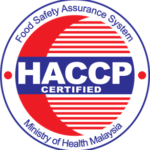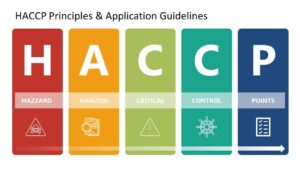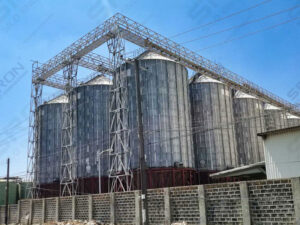HACCP Regulations or Guidelines for Powder Storage Hygiene
Hazard Analysis and Critical Control Points

HACCP guidelines for the storage of powder products, such as powdered food ingredients, focus on preventing contamination and ensuring product safety. Here are the key principles and practices for powder storage hygiene under HACCP:
- Hazard Analysis
- Identify potential hazards: Biological (bacteria, mold), chemical (contaminants), and physical (foreign objects).
- Assess risks: Evaluate the likelihood and severity of each hazard.
- Critical Control Points (CCP)
- Establish CCPs: Determine where controls are necessary to prevent or eliminate hazards. For powder storage, CCPs might include storage conditions, handling procedures, and packaging integrity.
- Critical Limits
- Set limits: Define acceptable parameters for storage conditions such as temperature, humidity, and contamination levels. For example, maintaining a specific humidity level to prevent clumping or mold growth.
- Monitoring Procedures
- Regular checks: Implement routine monitoring of storage conditions. This could include temperature and humidity logs, as well as inspections for signs of contamination or damage.
- Corrective Actions
- Immediate response: Have procedures in place to address deviations from critical limits, such as adjusting storage conditions or disposing of contaminated products.
- Verification Procedures
- Review and validate: Conduct regular audits and reviews of storage practices to ensure HACCP plan effectiveness. This might involve microbial testing or reviewing monitoring records.
- Record-Keeping
- Documentation: Maintain detailed records of monitoring activities, corrective actions, and verification procedures. This helps in tracking compliance and identifying areas for improvement.
Specific storage guidelines
- Temperature and Humidity Control
- Store powders in a cool, dry place, ideally with controlled temperature and humidity to prevent clumping and microbial growth.
- Use dehumidifiers and air conditioning if necessary.
- Cleanliness
- Keep storage areas clean and free from pests. Regular cleaning schedules should be established and followed.
- Implement strict hygiene protocols for personnel handling the powders.
- Packaging Integrity
- Ensure all powders are stored in appropriate, sealed containers to protect against contamination.
- Regularly inspect packaging for damage or signs of tampering.
- Pest Control
- Implement effective pest control measures, including traps and regular inspections.
- Keep storage areas free from food debris and other attractants.
- FIFO (First In, First Out)
- Practice FIFO inventory management to ensure older stock is used before newer stock, reducing the risk of spoilage.
- Labeling and Traceability
- Properly label all storage containers with product information, batch numbers, and expiration dates.
- Maintain traceability records to quickly identify and isolate any issues with specific batches.
Best time frame for regular cleaning

The time frame for regular cleaning in a storage area for powders can vary depending on the specific environment, volume of product handled, and potential contamination risks. However, here are some general guidelines:
- Daily Cleaning
- High-touch surfaces: Clean and sanitize frequently touched surfaces such as door handles, switches, and workstations.
- Spill management: Immediately clean up any spills or residue to prevent attracting pests and to avoid contamination.
- Floor cleaning: Sweep or vacuum floors daily to remove dust and debris.
- Weekly Cleaning
- Deep cleaning of floors: Mop or scrub floors to remove any built-up residue.
- Shelving and storage units: Wipe down and sanitize shelves, bins, and storage racks.
- Equipment: Clean and sanitize any equipment used in the storage area, such as forklifts or carts.
- Monthly Cleaning
- Walls and ceilings: Dust and clean walls and ceilings to prevent the buildup of dust and potential mold growth.
- Ventilation systems: Inspect and clean air vents and filters to ensure proper airflow and to prevent contamination from dust particles.
- Pest control inspection: Conduct a thorough inspection for signs of pest activity and take necessary actions if any issues are found.
- Quarterly Cleaning
- Deep cleaning: Conduct a more comprehensive deep cleaning of the entire storage area, including any hard-to-reach spots.
- Inventory check: Perform a detailed inventory check and clean out any expired or damaged products.
- Maintenance checks: Inspect and maintain storage infrastructure, such as checking for any leaks or damage to the structure that could affect storage conditions.
- Annual Cleaning
- Full facility audit: Conduct a full audit of the storage facility, ensuring compliance with HACCP and other relevant standards.
- Training review: Refresh and update staff training on cleaning procedures and HACCP compliance.
- As Needed
- After contamination incidents: If there is a spill, pest infestation, or other contamination event, clean and sanitize the affected area immediately.
- Regular monitoring: Adjust cleaning frequency based on monitoring results and seasonal changes that might affect storage conditions.
Best time frame for regular cleaning of food storage bin or silo

For food ingredients storage bins or silos, a well-defined cleaning schedule is essential to maintain hygiene, prevent contamination, and ensure product quality. Here is a recommended time frame for the regular cleaning of food storage bins or silos:
- Daily
- Visual Inspection: Conduct a visual inspection of storage bins or silos to check for any signs of contamination, spills, or pest activity.
- Surface Cleaning: Wipe down accessible surfaces, hatches, and entry points to remove any dust or residue. Ensure that seals and gaskets are clean and in good condition.
- Weekly
- Minor Cleaning:** Wipe down and vacuum accessible interior surfaces to prevent dust build-up. Ensure that seals and gaskets are clean and in good condition.
- Monthly
- Detailed Interior Cleaning: Clean the interior surfaces of the storage bin or silo that can be accessed without complete emptying. Focus on areas where flour tends to accumulate and compact.
- Quarterly
- Partial Emptying and Cleaning: If possible, partially empty the bin or silo and perform a thorough cleaning of the interior surfaces. This includes brushing and vacuuming compacted flour and residue.
- Semi-Annually
- Comprehensive Cleaning: Completely empty the storage bin or silo and conduct a comprehensive cleaning. This involves:
- Mechanical Cleaning: Using brushes, vacuums, and other tools to remove all flour residue.
- Washing and Sanitizing: If the structure allows, wash the interior surfaces with water and appropriate cleaning agents, followed by sanitizing.
- Drying: Ensure the bin or silo is completely dry before refilling to prevent mold growth.
- Comprehensive Cleaning: Completely empty the storage bin or silo and conduct a comprehensive cleaning. This involves:
- Annually
- Deep Cleaning and Inspection: Perform a deep cleaning and thorough inspection of the entire structure. This includes:
- Structural Integrity Check: Inspect for wear, corrosion, or damage.
- Maintenance: Perform necessary maintenance or repairs identified during the inspection.
- Deep Cleaning and Inspection: Perform a deep cleaning and thorough inspection of the entire structure. This includes:
- As Needed
- After Contamination or Infestation: Clean and sanitize the bin or silo immediately if contamination (e.g., mold, pests) is detected.
- Product Changeover: Thoroughly clean the bin or silo when switching between different types of flour to prevent cross-contamination.
- General Tips:
- Use Appropriate Tools: Utilize cleaning tools and equipment suitable for flour storage bins or silos.
- Safety Precautions: Follow safety regulations, including proper ventilation and the use of personal protective equipment (PPE).
- Documentation: Maintain detailed records of cleaning schedules, procedures, and inspections to ensure compliance with HACCP guidelines and other relevant standards.
References
The cleaning schedules and guidelines provided above are based on best practices derived from industry standards, food safety protocols, and HACCP (Hazard Analysis and Critical Control Points) principles. Here are some references and sources that informed these guidelines:
- HACCP Principles & Guidelines:
- U.S. Food and Drug Administration (FDA): [Hazard Analysis Critical Control Point (HACCP)](https://www.fda.gov/food/guidance-regulation-food-and-dietary-supplements/hazard-analysis-critical-control-point-haccp)
- U.S. Department of Agriculture (USDA): [Hazard Analysis and Critical Control Point (HACCP) Systems](https://www.fsis.usda.gov/wps/portal/fsis/topics/regulatory-compliance/haccp)
- Food Safety and Storage Recommendations:
- Food and Agriculture Organization (FAO): [FAO Food Safety Guidelines](http://www.fao.org/food-safety/en/)
- National Sanitation Foundation (NSF): [NSF International Food Safety Standards](http://www.nsf.org/)
- Best Practices for Cleaning and Maintenance:
- Grain and Feed Trade Association (GAFTA): [Grain Storage and Handling Guidelines](https://www.gafta.com/)
- National Grain and Feed Association (NGFA): [NGFA Safety and Environmental Compliance Manual](https://www.ngfa.org/)
- Pest Management and Hygiene:
- International Association for Food Protection (IAFP): [Food Protection Trends](https://www.foodprotection.org/)
- Pest Management Standards for Food Processing and Handling Facilities: [NPMA Standards](https://npmapestworld.org/)
Malaysian local authorities

In Malaysia, several local authorities and regulatory bodies oversee the regulations and guidelines for the regular cleaning and hygiene of food storage facilities, including storage bins and silos. The key authorities include:
- Ministry of Health (MOH) Malaysia
- Food Safety and Quality Division (FSQD): This division is responsible for ensuring food safety and hygiene standards across the country. They enforce regulations related to food storage, handling, and processing.
- Food Hygiene Regulations 2009: This set of regulations outlines the requirements for maintaining hygiene in food premises, including storage facilities.
- Department of Veterinary Services (DVS)
- Control of Animal Feed Act 2009: This act includes guidelines on the storage and handling of animal feed, which can be relevant for flour storage facilities that also handle feed products.
- Standards Malaysia
- Malaysian Standards (MS): Standards Malaysia develops and promotes standards that ensure product safety and quality. Relevant standards for food storage may include MS ISO 22000, which deals with food safety management systems.
- Local Municipal Councils
- Local Authority By-Laws: Various local municipal councils enforce their own by-laws regarding hygiene and sanitation in food storage and handling facilities within their jurisdictions.
- Department of Occupational Safety and Health (DOSH)
- Occupational Safety and Health Act 1994: This act includes provisions for maintaining a safe working environment, which can encompass the cleanliness and safety of storage facilities.
- Federation of Malaysian Manufacturers (FMM)
- Food Manufacturing Group (FMM-MAFMAG): This group within FMM focuses on issues related to food manufacturing, including best practices for storage and hygiene.
In Malaysia, non-compliance with food safety and hygiene regulations can result in various penalties, including fines, imprisonment, or both. The specific penalties depend on the nature and severity of the violation, as well as the applicable laws and regulations. Here are some key penalties for non-compliance:
- Food Hygiene Regulations 2009 – Under the Food Hygiene Regulations 2009, enforced by the Ministry of Health (MOH):
- General Offenses: Any person who contravenes any provision of these regulations commits an offense and, upon conviction, can be fined up to RM 10,000 or imprisoned for up to 2 years, or both.
- Food Act 1983 – Under the Food Act 1983, also enforced by the MOH:
- Section 13 (Offences in relation to preparation, sale, and use of food):
- For a first offense, the penalty can be a fine not exceeding RM 100,000 or imprisonment for a term not exceeding 10 years, or both.
- For a subsequent offense, the penalty can be a fine not exceeding RM 200,000 or imprisonment for a term not exceeding 20 years, or both.
- Section 13 (Offences in relation to preparation, sale, and use of food):
- Control of Animal Feed Act 2009 – For facilities dealing with animal feed:
- General Penalties: Any person who contravenes any provision of this act or any regulations made under it may be liable to a fine not exceeding RM 100,000 or imprisonment for a term not exceeding 2 years, or both.
- Occupational Safety and Health Act 1994 – Administered by the Department of Occupational Safety and Health (DOSH):
- General Penalty: For offenses not specifically mentioned under this act, the penalty can be a fine not exceeding RM 50,000 or imprisonment for a term not exceeding 2 years, or both.
- Serious Violations: More severe penalties may apply for serious violations that lead to hazardous working conditions or endanger worker safety.
- Local Municipal By-Laws – Penalties for non-compliance with local municipal council by-laws can vary but typically include:
- Fines: Specific amounts depend on the local by-law but can range from several hundred to several thousand Ringgit.
- Closure Orders: Authorities can order the closure of facilities until they comply with hygiene and safety standards.
- Enforcement Actions – In addition to fines and imprisonment, non-compliance can lead to other enforcement actions such as:
- Revocation of Licenses: Operating licenses can be suspended or revoked for serious or repeated violations.
- Product Recalls: Contaminated or unsafe products can be recalled from the market.
- Public Notification: Authorities may issue public warnings about non-compliant facilities.



